Abstract
Woolfolk, C. A. (University of Washington, Seattle) and H. R. Whiteley. Reduction of inorganic compounds with molecular hydrogen by Micrococcus lactilyticus. I. Stoichiometry with compounds of arsenic, selenium, tellurium, transition and other elements. J. Bacteriol. 84:647–658. 1962.—Extracts of Micrococcus lactilyticus (Veillonella alcalescens) oxidize molecular hydrogen at the expense of certain compounds of arsenic, bismuth, selenium, tellurium, lead, thallium, vanadium, manganese, iron, copper, molybdenum, tungsten, osmium, ruthenium, gold, silver, and uranium, as well as molecular oxygen. Chemical and manometric data indicate that the following reductions are essentially quantitative: arsenate to arsenite, pentavalent and trivalent bismuth to the free element, selenite via elemental selenium to selenide, tellurate and tellurite to tellurium, lead dioxide and manganese dioxide to the divalent state, ferric to ferrous iron, osmium tetroxide to osmate ion, osmium dioxide and trivalent osmium to the metal, uranyl uranium to the tetravalent state, vanadate to the level of vanadyl, and polymolybdate ions to molybdenum blues with an average valence for molybdenum of +5. The results of a study of certain other hydrogenase-containing bacteria with respect to their ability to carry out some of the same reactions are also presented.
Full text
PDF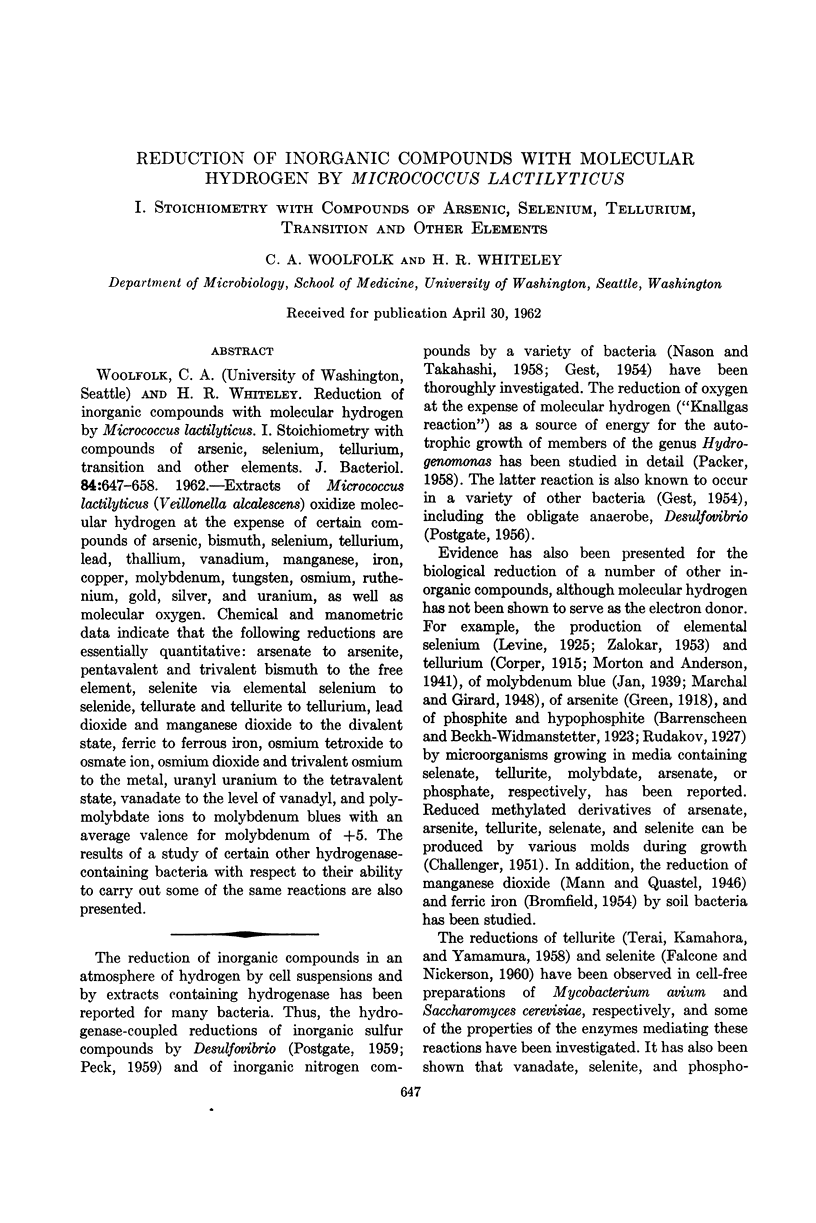
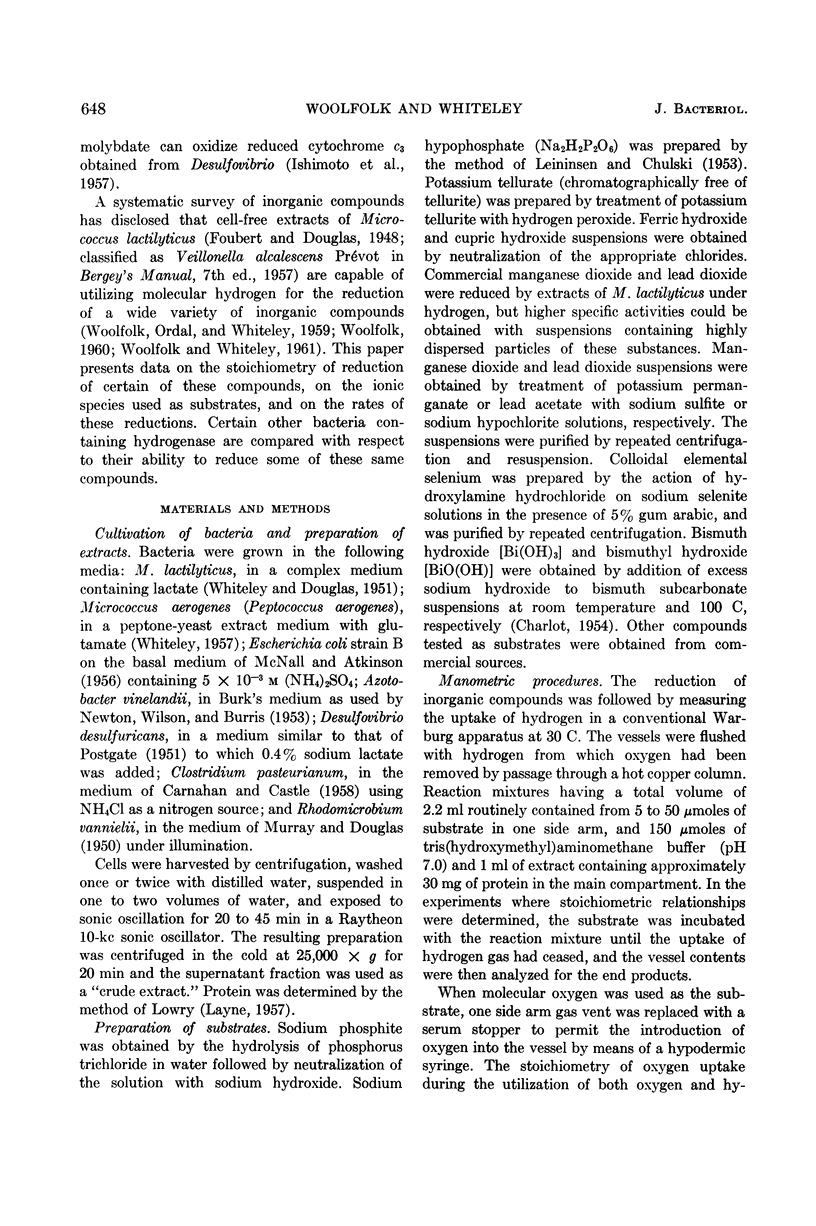
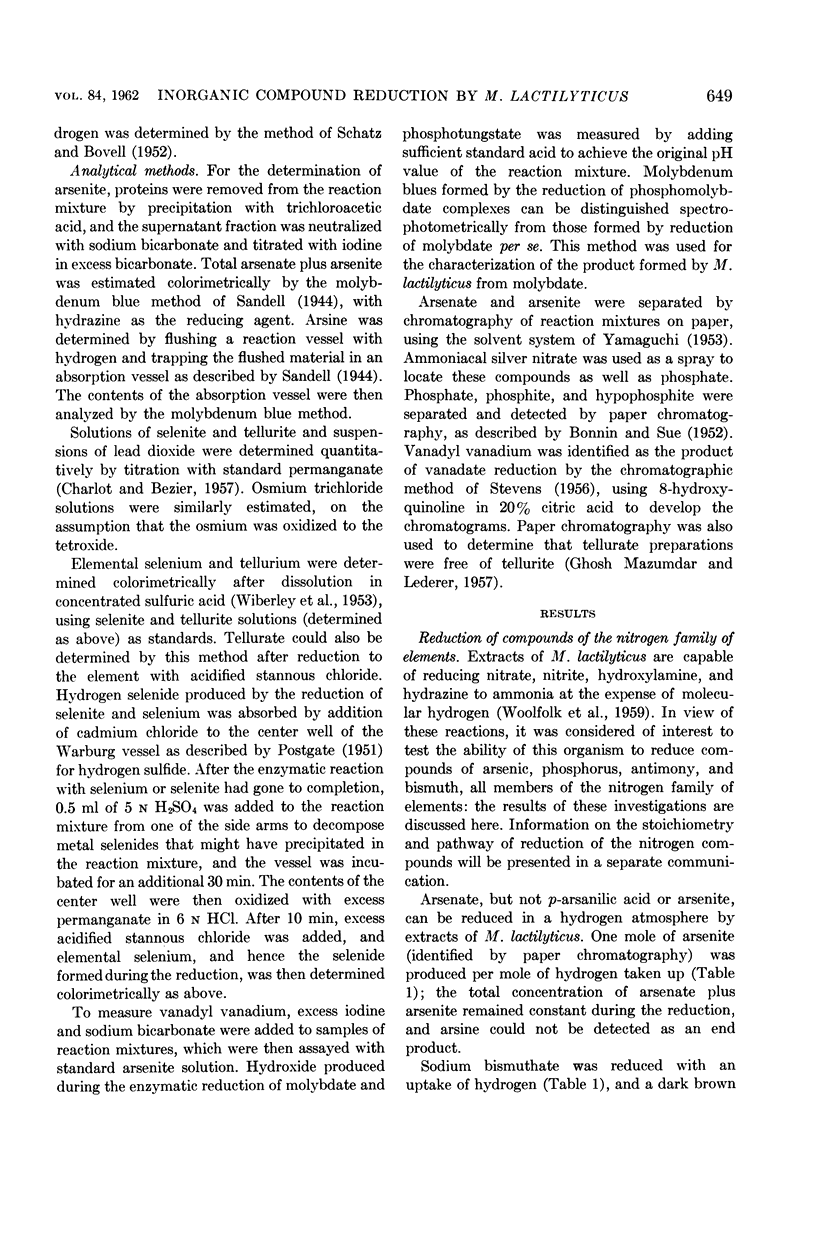
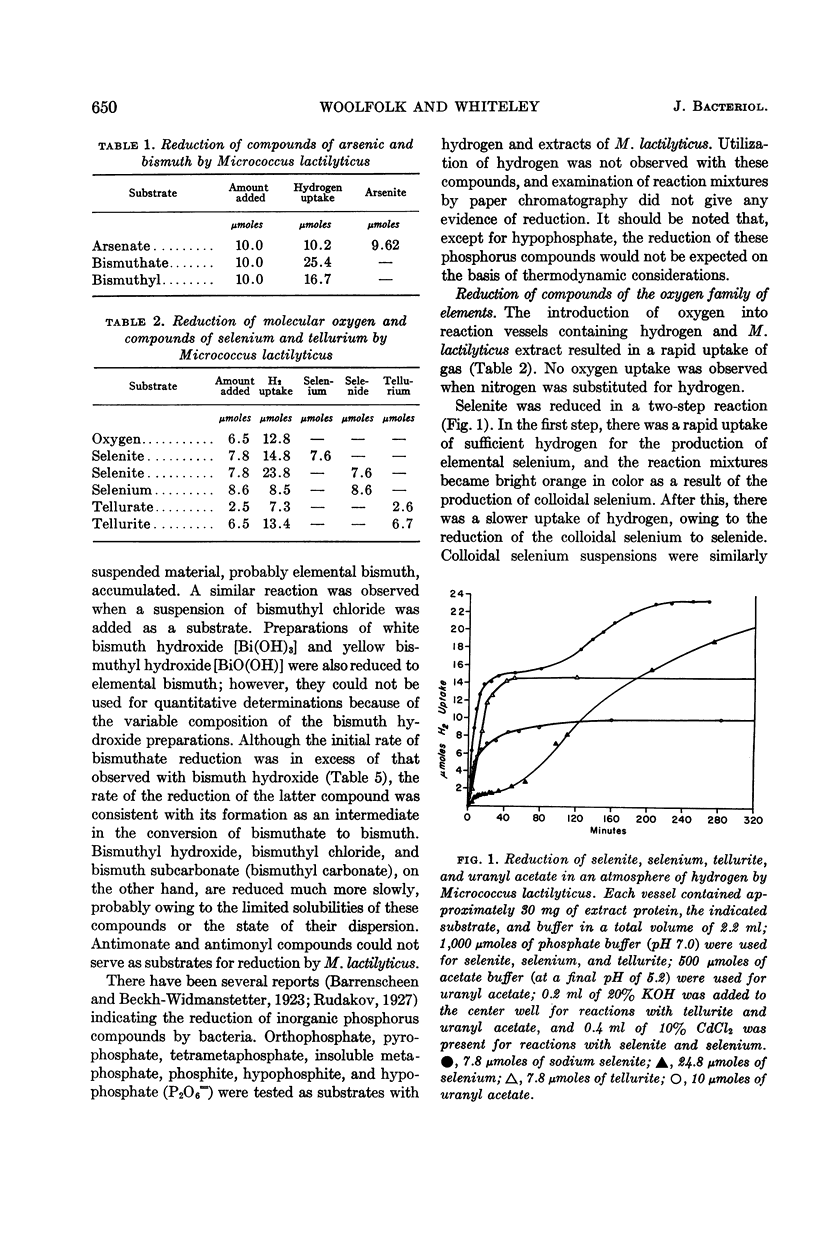
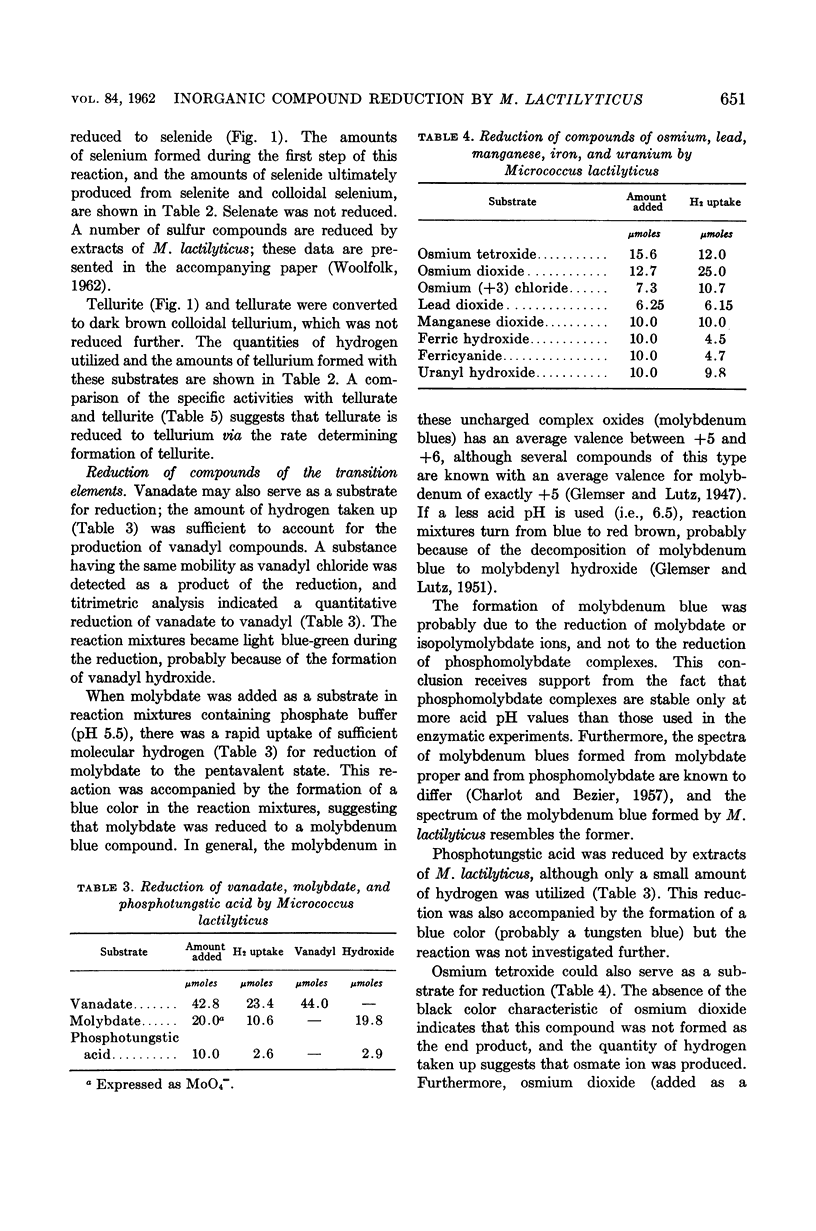
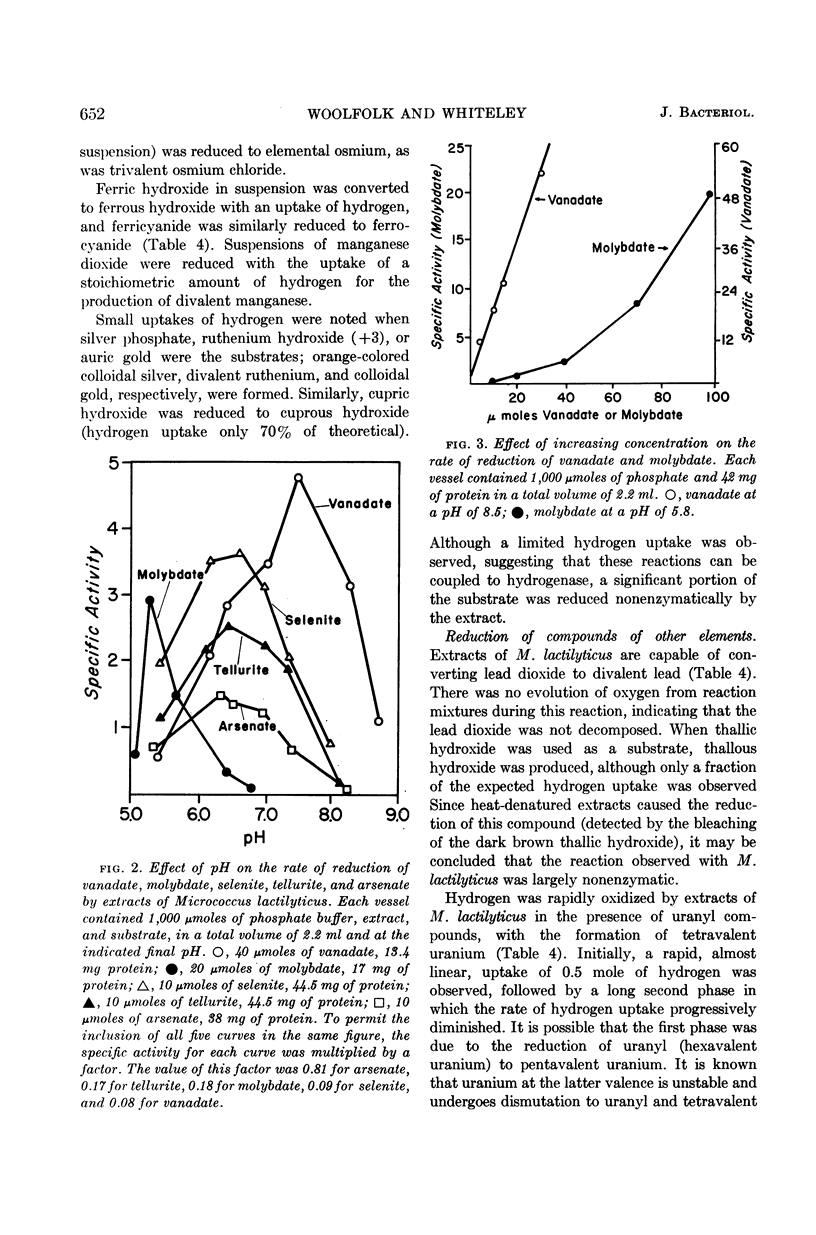
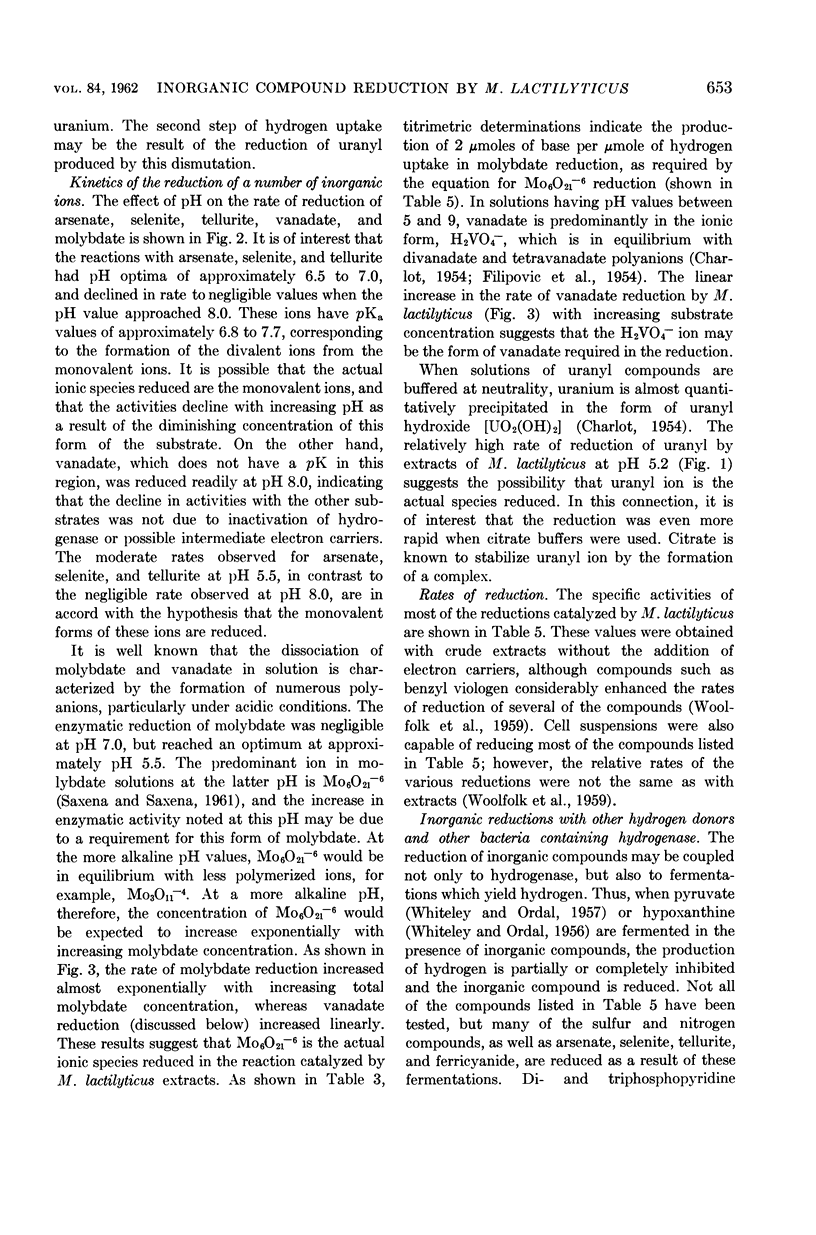
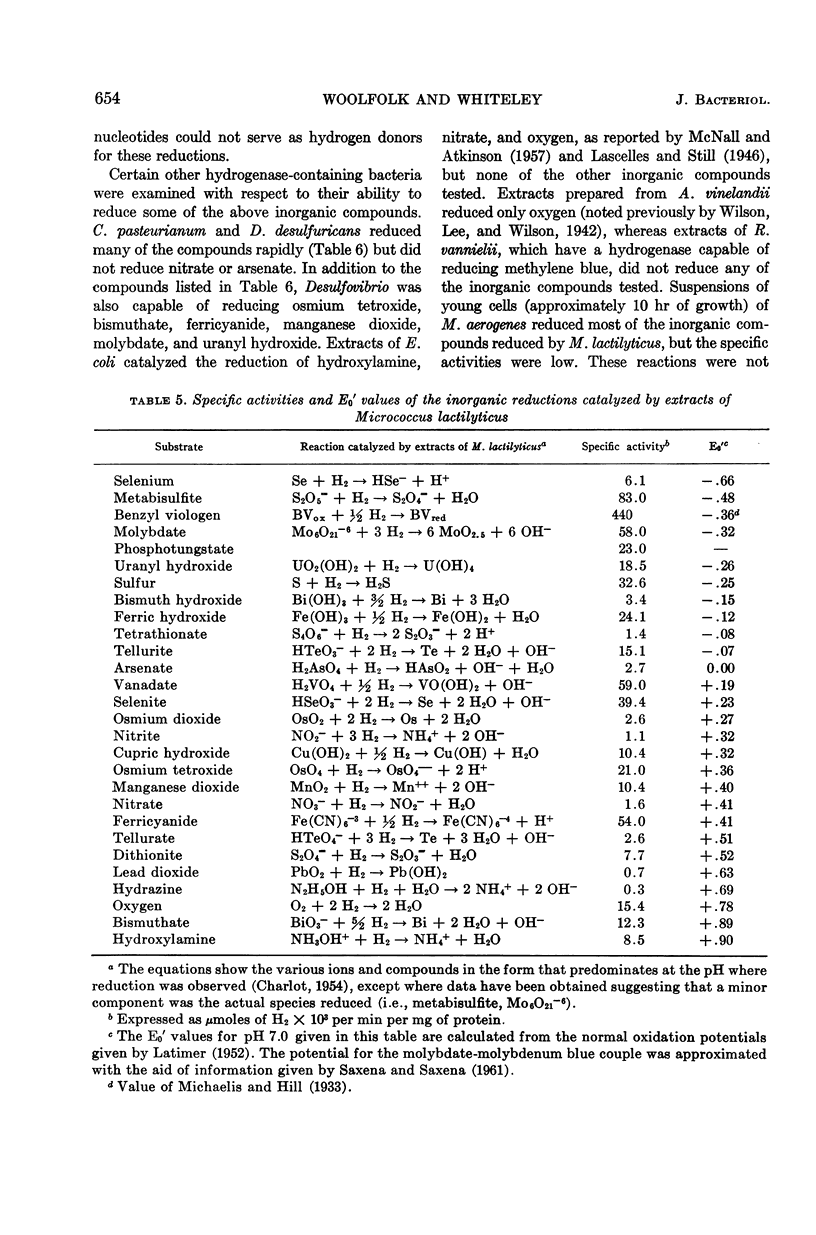
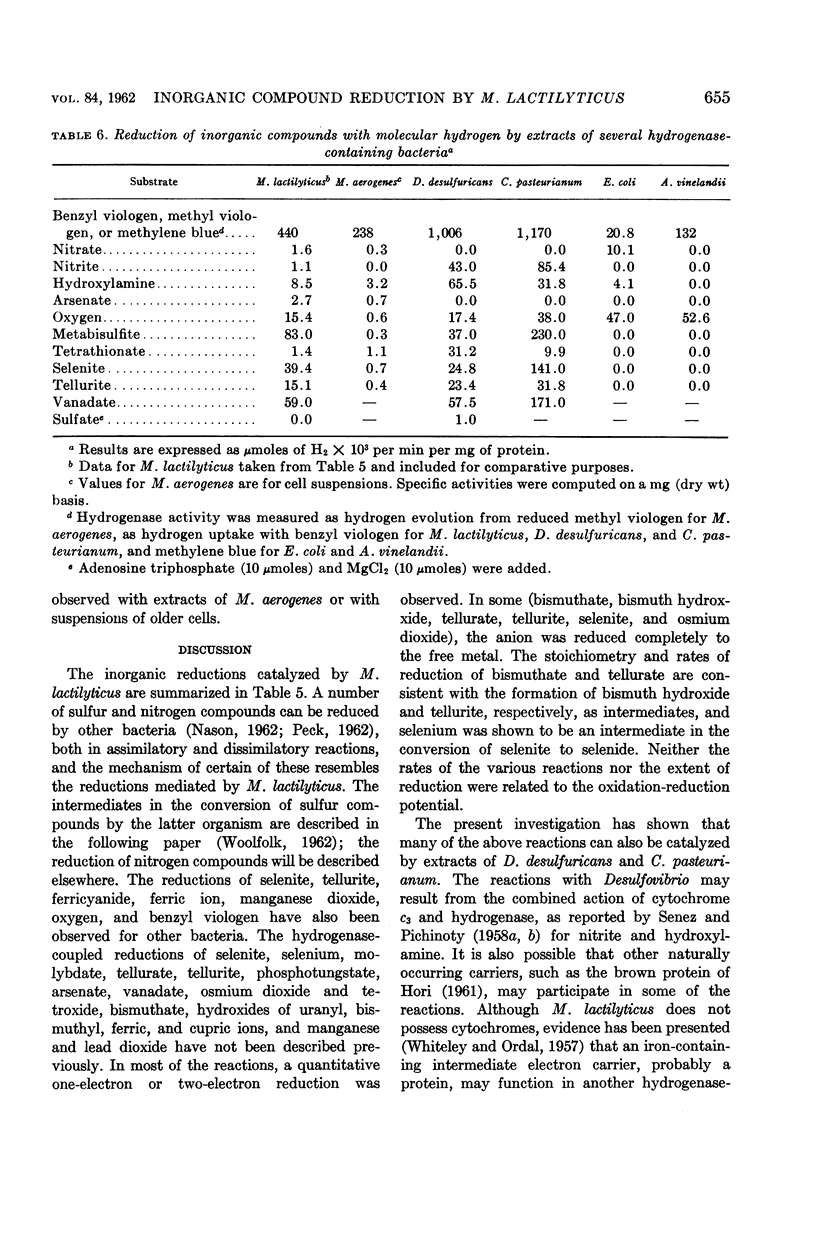
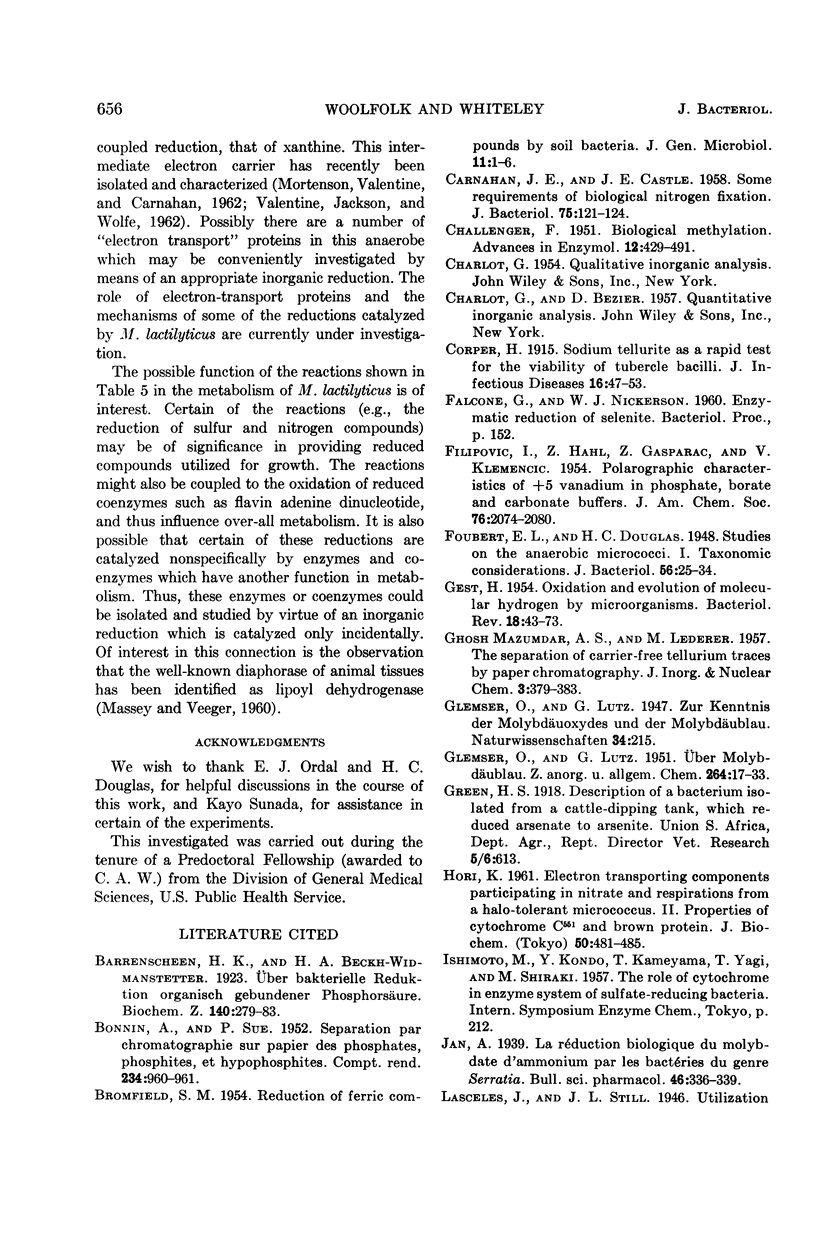
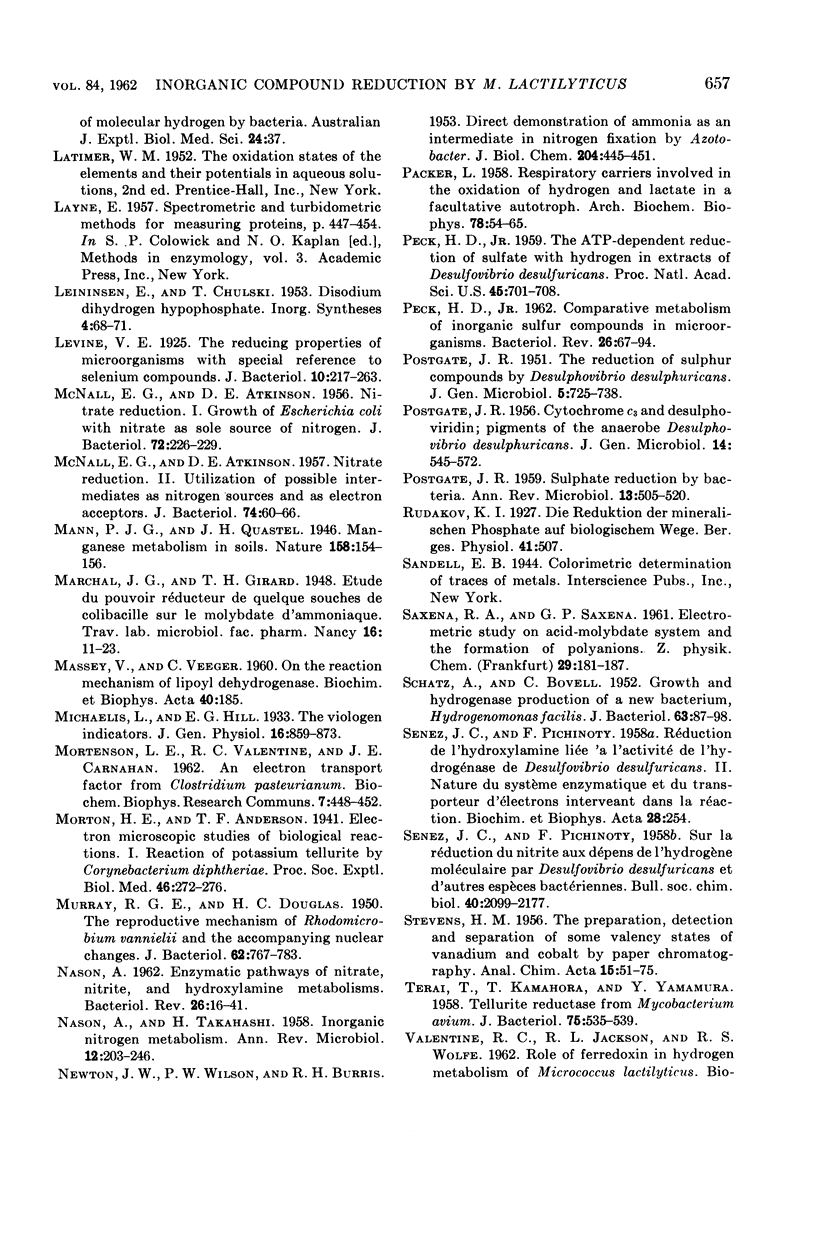
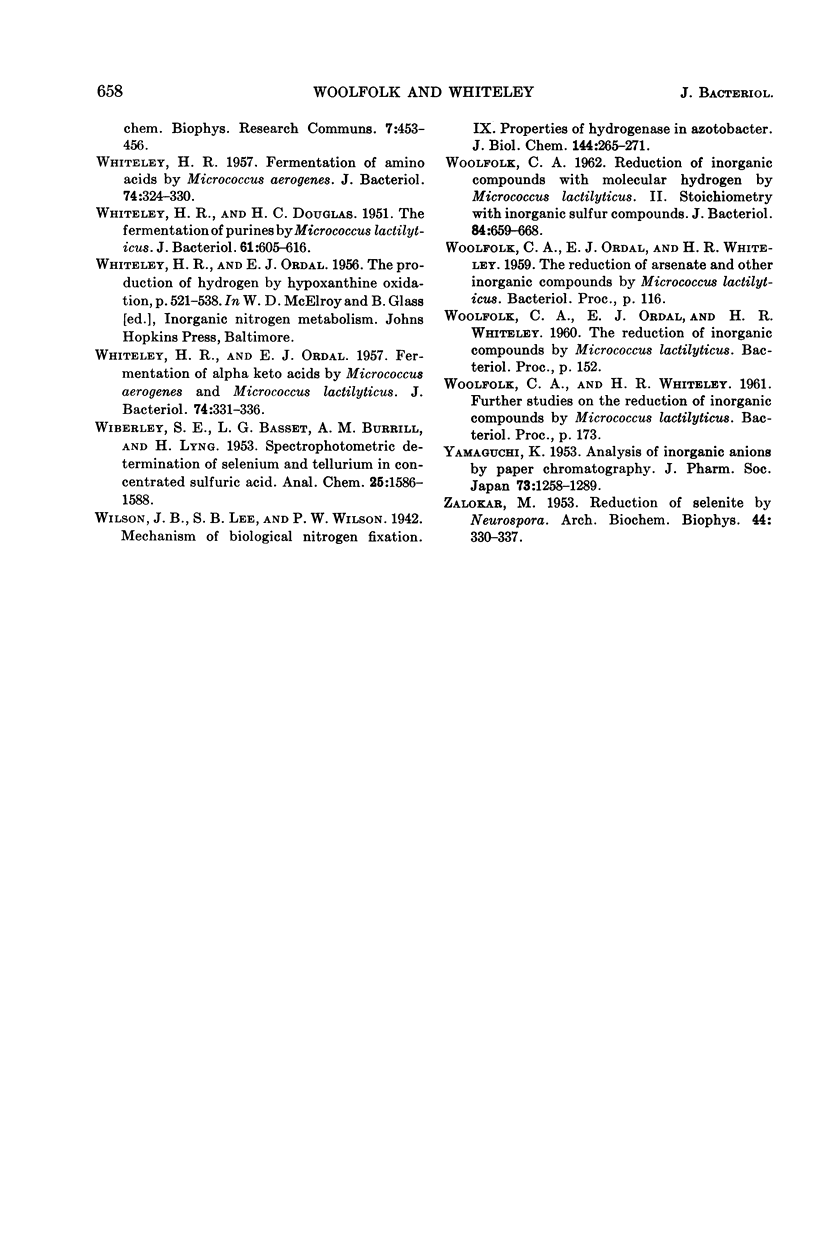
Selected References
These references are in PubMed. This may not be the complete list of references from this article.
- ATKINSON D. E., MCNALL E. G. Nitrate reduction. I. Growth of Escherichia coli with nitrate as sole source of nitrogen. J Bacteriol. 1956 Aug;72(2):226–229. doi: 10.1128/jb.72.2.226-229.1956. [DOI] [PMC free article] [PubMed] [Google Scholar]
- BROMFIELD S. M. Reduction of ferric compounds by soil bacteria. J Gen Microbiol. 1954 Aug;11(1):1–6. doi: 10.1099/00221287-11-1-1. [DOI] [PubMed] [Google Scholar]
- CARNAHAN J. E., CASTLE J. E. Some requirements of biological nitrogen fixation. J Bacteriol. 1958 Feb;75(2):121–124. doi: 10.1128/jb.75.2.121-124.1958. [DOI] [PMC free article] [PubMed] [Google Scholar]
- CHALLENGER F. Biological methylation. Adv Enzymol Relat Subj Biochem. 1951;12:429–491. doi: 10.1002/9780470122570.ch8. [DOI] [PubMed] [Google Scholar]
- Foubert E. L., Douglas H. C. Studies on the Anaerobic Micrococci: I. Taxonomic Considerations. J Bacteriol. 1948 Jul;56(1):25–34. [PMC free article] [PubMed] [Google Scholar]
- GEST H. Oxidation and evolution of molecular hydrogen by microorganisms. Bacteriol Rev. 1954 Mar;18(1):43–73. doi: 10.1128/br.18.1.43-73.1954. [DOI] [PMC free article] [PubMed] [Google Scholar]
- HORI K. Electron transporting components participating in nitrate and oxygen respirations from a halotolerant Micrococcus. II. Properties of cytochrome c551 and brown protein. J Biochem. 1961 Dec;50:481–485. doi: 10.1093/oxfordjournals.jbchem.a127479. [DOI] [PubMed] [Google Scholar]
- Levine V. E. THE REDUCING PROPERTIES OF MICROORGANISMS WITH SPECIAL REFERENCE TO SELENIUM COMPOUNDS. J Bacteriol. 1925 May;10(3):217–263. doi: 10.1128/jb.10.3.217-263.1925. [DOI] [PMC free article] [PubMed] [Google Scholar]
- MASSEY V., VEEGER C. On the reaction mechanism of lipoyl dehydrogenase. Biochim Biophys Acta. 1960 May 6;40:184–185. doi: 10.1016/0006-3002(60)91337-8. [DOI] [PubMed] [Google Scholar]
- MORTENSON L. E., VALENTINE R. C., CARNAHAN J. E. An electron transport factor from Clostridium pasteurianum. Biochem Biophys Res Commun. 1962 Jun 4;7:448–452. doi: 10.1016/0006-291x(62)90333-9. [DOI] [PubMed] [Google Scholar]
- McNALL E. G., ATKINSON D. E. Nitrate reduction. II. Utilization of possible intermediates as nitrogen sources and as electron acceptors. J Bacteriol. 1957 Jul;74(1):60–66. doi: 10.1128/jb.74.1.60-66.1957. [DOI] [PMC free article] [PubMed] [Google Scholar]
- NASON A. Symposium on metabolism of inorganic compounds. II. Enzymatic pathways of nitrate, nitrite, and hydroxylamine metabolisms. Bacteriol Rev. 1962 Mar;26:16–41. doi: 10.1128/br.26.1.16-41.1962. [DOI] [PMC free article] [PubMed] [Google Scholar]
- NASON A., TAKAHASHI H. Inorganic nitrogen metabolism. Annu Rev Microbiol. 1958;12:203–246. doi: 10.1146/annurev.mi.12.100158.001223. [DOI] [PubMed] [Google Scholar]
- NEWTON J. W., WILSON P. W., BURRIS R. H. Direct demonstration of ammonia as an intermediate in nitrogen fixation by Azotobacter. J Biol Chem. 1953 Sep;204(1):445–451. [PubMed] [Google Scholar]
- PECK H. D., Jr Symposium on metabolism of inorganic compounds. V. Comparative metabolism of inorganic sulfur compounds in microorganisms. Bacteriol Rev. 1962 Mar;26:67–94. doi: 10.1128/br.26.1.67-94.1962. [DOI] [PMC free article] [PubMed] [Google Scholar]
- POSTGATE J. R. Cytochrome c3 and desulphoviridin; pigments of the anaerobe Desulphovibrio desulphuricans. J Gen Microbiol. 1956 Jul;14(3):545–572. doi: 10.1099/00221287-14-3-545. [DOI] [PubMed] [Google Scholar]
- POSTGATE J. R. The reduction of sulphur compounds by Desulphovibrio desulphuricans. J Gen Microbiol. 1951 Oct;5(4):725–738. doi: 10.1099/00221287-5-4-725. [DOI] [PubMed] [Google Scholar]
- Peck H. D. THE ATP-DEPENDENT REDUCTION OF SULFATE WITH HYDROGEN IN EXTRACTS OF DESULFOVIBRIO DESULFURICANS. Proc Natl Acad Sci U S A. 1959 May;45(5):701–708. doi: 10.1073/pnas.45.5.701. [DOI] [PMC free article] [PubMed] [Google Scholar]
- SCHATZ A., BOVELL C., Jr Growth and hydrogenase activity of a new bacterium, Hydrogenomonas facilis. J Bacteriol. 1952 Jan;63(1):87–98. doi: 10.1128/jb.63.1.87-98.1952. [DOI] [PMC free article] [PubMed] [Google Scholar]
- SENEZ J. C., PICHINOTY F. Sur la réduction du nitrite aux dépens de l'hydrogène moléculaire par Desulfovibrio desulfuricans et d'autres espèces bactériennes. Bull Soc Chim Biol (Paris) 1958;40(12):2099–2117. [PubMed] [Google Scholar]
- TERAI T., KAMAHORA T., YAMAMURA Y. Tellurite reductase from Mycobacterium avium. J Bacteriol. 1958 May;75(5):535–539. doi: 10.1128/jb.75.5.535-539.1958. [DOI] [PMC free article] [PubMed] [Google Scholar]
- VALENTINE R. C., JACKSON R. L., WOLFE R. S. Role of ferredoxin in hydrogen metabolism of Micrococcus lactilyticus. Biochem Biophys Res Commun. 1962 Jun 4;7:453–456. doi: 10.1016/0006-291x(62)90334-0. [DOI] [PubMed] [Google Scholar]
- WHITELEY H. R., DOUGLAS H. C. The fermentation of purines by Micrococcus lactilyticus. J Bacteriol. 1951 May;61(5):605–616. doi: 10.1128/jb.61.5.605-616.1951. [DOI] [PMC free article] [PubMed] [Google Scholar]
- WHITELEY H. R. Fermentation of amino acids by Micrococcus aerogenes. J Bacteriol. 1957 Sep;74(3):324–330. doi: 10.1128/jb.74.3.324-330.1957. [DOI] [PMC free article] [PubMed] [Google Scholar]
- WHITELEY H. R., ORDAL E. J. Fermentation of alpha keto acids by Micrococcus aerogenes and Micrococcus lactilyticus. J Bacteriol. 1957 Sep;74(3):331–336. doi: 10.1128/jb.74.3.331-336.1957. [DOI] [PMC free article] [PubMed] [Google Scholar]
- WOOLFOLK C. A. Reduction of inorganic compounds with molecular hydrogen by Micrococcus lactilyticus. II. Stoichiometry with inorganic sulfur compounds. J Bacteriol. 1962 Oct;84:659–668. doi: 10.1128/jb.84.4.659-668.1962. [DOI] [PMC free article] [PubMed] [Google Scholar]
- ZALOKAR M. Reduction of selenite by Neurospora. Arch Biochem Biophys. 1953 Jun;44(2):330–337. doi: 10.1016/0003-9861(53)90051-4. [DOI] [PubMed] [Google Scholar]


